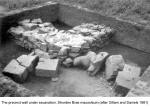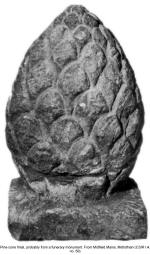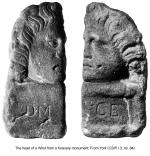Grave monuments
Introduction
The majority of graves must have been marked by posts, low mounds, fences,
or lines of stones, with only a minority having a tombstone of any type. The
rich sometimes had a grave monument in the form of a building rather than just
a grave marker, but Britain does not seem to have developed any distinctive
forms of its own for such monuments, the surviving examples being types known
elsewhere in the Empire.
Earth structures
Barrow
Pre Roman
It is often difficult to identify any form of late Iron Age burial in
much of Britain, apart from in the south-east where there are numerous cremation
cemeteries. In southern England a small number of the elite had their graves
marked by circular earth mounds, some of which may have made use of pre-existing
barrows. One of the largest Iron Age barrows is the Lexden Tumulus at Colchester,
Essex. It is dated to c.10BC, contained a burial with very rich grave goods, and was originally 30m in
diameter and 3m high.
Early Roman

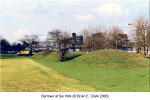 The use of barrows for the rich continued into the early Roman period,
although it was typical for them to be constructed in groups. At Bartlow Hills
near Cambridge there were originally eight barrows in two rows, dated by their
grave goods to the late first or early second century. They had a steep conical
shape, and were originally surrounded by a ditch. The largest one still surviving
(the largest in Britain) is 44m in diameter
and 14m tall. At Six Hills at Stevenage there are six round barrows, originally
surrounded by ditches and with a larger boundary ditch, which were set up by
the side of a Roman road. There is no indication of how, if at all, the people
passing these monuments knew who were buried there.
The use of barrows for the rich continued into the early Roman period,
although it was typical for them to be constructed in groups. At Bartlow Hills
near Cambridge there were originally eight barrows in two rows, dated by their
grave goods to the late first or early second century. They had a steep conical
shape, and were originally surrounded by a ditch. The largest one still surviving
(the largest in Britain) is 44m in diameter
and 14m tall. At Six Hills at Stevenage there are six round barrows, originally
surrounded by ditches and with a larger boundary ditch, which were set up by
the side of a Roman road. There is no indication of how, if at all, the people
passing these monuments knew who were buried there.
Stone structures
The purpose of having a large grave monument in the Roman period was for
remembrance so that a person’s name would live on (Reece 1977, 44). A stone-built
structure would allow for an inscription, and a number of surviving tombstones
with the inscription towards the bottom of the stone, with no unworked stone
below to be buried in the ground, must have been built into a monument of some
form.
Circular
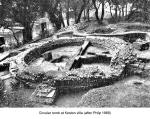
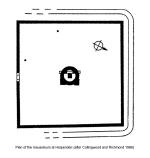 The circular shape of the earth structures was also repeated in stone.
Some had a low stone retaining wall round an earth mound, while others had
full-height stone walls. A tomb at the villa of Keston, Kent, probably built
in the early third century, had a diameter of 9m and may have originally been
6m high, with red opus signinum or plaster on the stone wall and an earth mound above (Philp et al 1991 and 1996). A mausoleum set in a precinct at Harpenden, Hertfordshire had
full-height stone walls, with additions at the front to create an elaborate
façade. The interior had a central altar and a statue in a niche in the back wall
(Collingwood and Richmond 1969, 171). It is clear that people were supposed
to enter this chamber, unlike the other type of monument, where the burial
chamber was concealed within the earth-mound.
The circular shape of the earth structures was also repeated in stone.
Some had a low stone retaining wall round an earth mound, while others had
full-height stone walls. A tomb at the villa of Keston, Kent, probably built
in the early third century, had a diameter of 9m and may have originally been
6m high, with red opus signinum or plaster on the stone wall and an earth mound above (Philp et al 1991 and 1996). A mausoleum set in a precinct at Harpenden, Hertfordshire had
full-height stone walls, with additions at the front to create an elaborate
façade. The interior had a central altar and a statue in a niche in the back wall
(Collingwood and Richmond 1969, 171). It is clear that people were supposed
to enter this chamber, unlike the other type of monument, where the burial
chamber was concealed within the earth-mound.
Square or rectangular
A new development in the Roman period, appearing by the late first or
early second century, was the square or rectangular grave monument. These had
thick walls round a central chamber. The body could be in a grave below ground
level, or placed in a sarcophagus set on the floor. It is likely some of these
structures were two or three stories high, but little evidence survives for
the form they took above ground level, nor their degree of architectural decoration.
Mausoleum
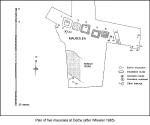
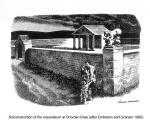
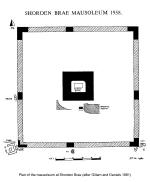 These were usually designed for single burials set into the floor. They
could be for both cremations, as in a row of five mausolea from the late first
or early second century at Derby, and for inhumations, as at a mausoleum at
Shorden Brae, Northumberland, dating to the second quarter of the second century
(Gillam and Daniels 1961). The
mausoleum at Shorden Brae consisted of a building approximately 10m square,
set in a precinct about 41m square marked by an outer perimeter wall. The corners
of the perimeter wall were decorated with sculpture depicting lions attacking
stags. Over 25 examples of this type of lion are known from Britain,
mainly from the north of the country, and are mainly second century in date
where they can
be dated (Brewer 1986, 23). Other types of sculpture likely to have come from
mausolea include pine-cone finials and large human heads, some clearly intended
to be set at the corners of buildings or walls (CSIR I.3, no. 84; CSIR I.4, no. 59; Brewer 1986, 26-7).
These were usually designed for single burials set into the floor. They
could be for both cremations, as in a row of five mausolea from the late first
or early second century at Derby, and for inhumations, as at a mausoleum at
Shorden Brae, Northumberland, dating to the second quarter of the second century
(Gillam and Daniels 1961). The
mausoleum at Shorden Brae consisted of a building approximately 10m square,
set in a precinct about 41m square marked by an outer perimeter wall. The corners
of the perimeter wall were decorated with sculpture depicting lions attacking
stags. Over 25 examples of this type of lion are known from Britain,
mainly from the north of the country, and are mainly second century in date
where they can
be dated (Brewer 1986, 23). Other types of sculpture likely to have come from
mausolea include pine-cone finials and large human heads, some clearly intended
to be set at the corners of buildings or walls (CSIR I.3, no. 84; CSIR I.4, no. 59; Brewer 1986, 26-7).
Temple-mausoleum
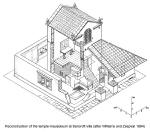 A number of sites in southern Britain have a combined temple-mausoleum
building (Williams and Zeepvat 1994, 100; 238). The example at the villa at
Bancroft, Buckinghamshire, built c.175-200, has a 12m square central building with ambulatory. It is distinguished
from a normal temple by having a below-ground burial chamber containing bases
to support two sarcophagi. The back-fill of this room also contained the bones from at least four individuals,
indicating multiple burials.
A number of sites in southern Britain have a combined temple-mausoleum
building (Williams and Zeepvat 1994, 100; 238). The example at the villa at
Bancroft, Buckinghamshire, built c.175-200, has a 12m square central building with ambulatory. It is distinguished
from a normal temple by having a below-ground burial chamber containing bases
to support two sarcophagi. The back-fill of this room also contained the bones from at least four individuals,
indicating multiple burials.
Again, this type of mausoleum was presumably designed so that people could
enter the room, either for rituals relating to the dead or simply for further
burials.
TWM
Bibliography
Collingwood, R. G. and Richmond, I. (1969) The
Archaeology of Britain (3rd edn), London
CSIR I.1 = Phillips, E. J. (1977) Corpus Signorum Imperii Romani: Great
Britain Volume I, Fascicule 1, Corbridge, Hadrian’s Wall East of the North
Tyne, Oxford.
CSIR I.3 = Rinaldi Tufi, S. (1983) Corpus Signorum Imperii Romani: Great
Britain Volume I, Fascicule 3, Yorkshire, Oxford.
CSIR I.4 = Keppie, L. J. F. and Arnold, B. J. (1984) Corpus Signorum Imperii
Romani: Great Britain Volume I, Fascicule 4, Scotland, Oxford.
Brewer, R. J. (1986) Corpus Signorum Imperii Romani: Great
Britain Volume I, Fascicule 5, Wales, Oxford.
Embleton, R. and Graham, F. (1990) Hadrian’s
Wall in the Days of the Romans, Newcastle upon Tyne
Gillam, J. P. and Daniels, C. M. (1961) ‘The Roman mausoleum on Shorden
Brae, Beaufront, Corbridge, Northumberland’, Archaeologia Aeliana 4th series, 39, 37-61.
Philp, B. (1968) ‘The excavation of the Roman cemetery at Keston’, Kent
Archaeological Review, 11, 10-5.
Philp, B., Parfitt, K., Wilson, J., Dutto, M. and Williams, W. (1991) The
Roman Villa Site at Keston, Kent. First Report (Excavations 1968-1978), Dover.
Philp, B., Parfitt, K., Wilson, J. and Williams, W. (1999) The
Roman Villa Site at Keston, Kent. Second Report (Excavations 1967 and 1978-1990), Dover.
Reece, R. (1977) ‘Burial in Latin literature: two examples’, in Reece,
R. (ed.) Burial in the Roman World, Council for British Archaeology Research Report 2, 44-5
Wheeler, H. (1985) The Racecourse Cemetery, in Dool, J. et
al, ‘Roman Derby: Excavations 1968-1983’, Derbyshire Archaeological Journal 105, 222-80
Williams, R. J. and Zeepvat, R. J. (1994) Bancroft.
A Late Bronze Age/Iron Age Settlement, Roman Villa and Temple Mausoleum, Buckinghamshire Archaeological Society Monograph no. 7.

 The use of barrows for the rich continued into the early Roman period,
although it was typical for them to be constructed in groups. At Bartlow Hills
near Cambridge there were originally eight barrows in two rows, dated by their
grave goods to the late first or early second century. They had a steep conical
shape, and were originally surrounded by a ditch. The largest one still surviving
(the largest in Britain) is 44m in diameter
and 14m tall. At Six Hills at Stevenage there are six round barrows, originally
surrounded by ditches and with a larger boundary ditch, which were set up by
the side of a Roman road. There is no indication of how, if at all, the people
passing these monuments knew who were buried there.
The use of barrows for the rich continued into the early Roman period,
although it was typical for them to be constructed in groups. At Bartlow Hills
near Cambridge there were originally eight barrows in two rows, dated by their
grave goods to the late first or early second century. They had a steep conical
shape, and were originally surrounded by a ditch. The largest one still surviving
(the largest in Britain) is 44m in diameter
and 14m tall. At Six Hills at Stevenage there are six round barrows, originally
surrounded by ditches and with a larger boundary ditch, which were set up by
the side of a Roman road. There is no indication of how, if at all, the people
passing these monuments knew who were buried there.




